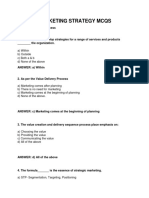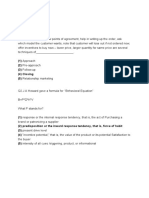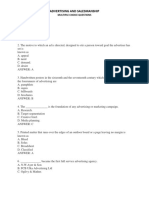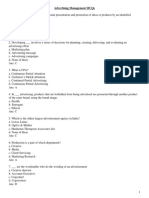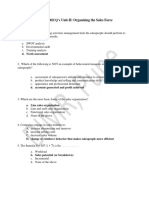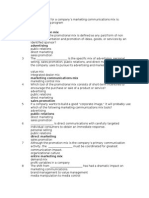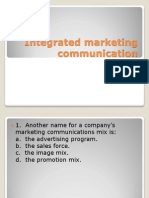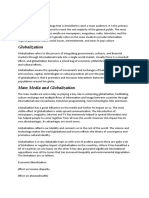MCQS On Media Planning PDF
MCQS On Media Planning PDF
Uploaded by
Huzaifa Aman AzizCopyright:
Available Formats
MCQS On Media Planning PDF
MCQS On Media Planning PDF
Uploaded by
Huzaifa Aman AzizOriginal Title
Copyright
Available Formats
Share this document
Did you find this document useful?
Is this content inappropriate?
Copyright:
Available Formats
MCQS On Media Planning PDF
MCQS On Media Planning PDF
Uploaded by
Huzaifa Aman AzizCopyright:
Available Formats
Question Bank On Media Planning and Management with Answers
1. Media literacy means the ability to
a. Read and write
b. Create professional media
c. Understand and use media
d. Prepare for a career in media
2. Good media criticism should always
a. Reveal negative aspects of media
b. Offer analysis based on reason
c. Warn us that ads sell us things we don't need
d. Condemn our emotional reactions to media
3. In media studies "converging" refers to the coming together of
a. Two or more people, in public
b. Different professional ideas about media
c. Computer, telephone, and mass media technologies
d. Mass media and mass communication
4. Economies of scale save a company money because they enable the company to
a. Make a large variety of products
b. Make many copies of a product
c. Scale down the size of their products
d. Charge higher prices than their competitors
5. In terms of media/government relationships in the world today, the media in most
countries are
a. Government owned and operated
b. Privately owned and government controlled
c. Privately owned and free from government control
d. Mixed in terms of government and private ownership and control
6. What is ABC?
a. American business circle
b. American business corporation
c. Audit Bureau of circulation
d. None
Prepared by : Darshana Bande from various sources available online
Question Bank On Media Planning and Management with Answers
7. A person (or group) who has control over what information is disseminated to the
audience is known as:
a. Newscaster
b. Reporter
c. Regulator
d. Gatekeeper
8. The news of important public events appearing in the front sections of a newspaper, is
called:
a. Soft-news
b. Hard-news
c. Feature News
d. Investigative news
9. The famous communication Model SMCRE was devised by:
a. Schramm
b. Roger
c. Lasswell
d. Osgood
10. The communication based on purchased time or space is called:
a. Propaganda
b. Publicity
c. Advertising
d. None of these
11. UPI is the abbreviation of:
a. United Press of India
b. United Press of Indonesia
c. United Press International
d. None of these
12. Communication without words:
a. Mass communication
b. Visual Communication
c. Non-Verbal communication
d. None of these
13. OB stands for:
a. Outside Broadcast
b. Outdoor Broadcast
c. Official Beat
d. None of these
Prepared by : Darshana Bande from various sources available online
Question Bank On Media Planning and Management with Answers
14. The Internet is:
a. An integral part of the Information Superhighway
b. An indirect product of the Cold War
c. A global network of interconnected computers
d. All of the above
15. ----------------- in advertising. is a series of decisions involvin g the delivery of message
to the targeted audience.
a. Market Analysis
b. Media Objective
c. Media Planning
d. Media Strategy
ANSWER: C
16. Every media plan begins with the--------------
a. media objective
b. market analysis
c. mediamix
d. media strategy
ANSWER: B
17. The --------------- of target audience help s media planner to understand the media
consumption habbits, and accordingly choose the most appropriate media mix.
A) analysis
B) identification
C) selection
D) classification
ANSWER: D
18. ----------------- describes what you want the media plan to accomplish.
A) Media Objective
B) Media analysis
C) Mediamix
D) Media strategy
ANSWER: A
19. ---------------- refers to the number of people that will be exposed to a media vehicle
at least once during a given period of time.
A) Frequency
B) Reach
C) CPM
D) CPP
ANSWER: B
Prepared by : Darshana Bande from various sources available online
Question Bank On Media Planning and Management with Answers
20. ---------------refers to the average number of times an individual within target
audience is exposed to a media vehicle during a given period of time.
A. Frequency
B. Reach
C. Continuity
D. CPM
ANSWER :A
21. An effective media strategy requires a degree of ----------- _
A. continuity
B. mediamix
C. flexibility
D. discontinuous
ANSWER: C
22. ------covers two broad decisions selectionof media class, and selection of media
vehicle with in media class.
A. Media mix
B. Media strategy
C. Media objective
D. Media selection
ANSWER: D
23. The implementation of media plan requires ------- _
A. Media slot
B. Mediamix
C. Media buying
D. Media selection
ANSWER C
24. Media Buying refers to buying ------ in the selected media.
A. slot
B. space
C. vehicle
D. time and space
ANSWER: D
25. …………is a way of describing audience based on factors such as age, gender,
education level, town class, income etc.
A. Demographic
B. Psycho graphic
C. Socio-economic
D. infographics
answer a
Prepared by : Darshana Bande from various sources available online
Question Bank On Media Planning and Management with Answers
26. ------- is away of describing audience based on the their life style,
attitudes, aspirations, habits etc.
A. Demographics
B. Psycho graphics
C. Socio-economic
D. Infographics
ANSWER B
27. Media--------- is a primary goal of advertising media planning and media
buying.
A. frequency
B. efficiency
C. flexibility
D. reach
ANSWER: B
28. Scheduling in ----------------- can help avoid the irritation factor and can
keep an advertising campaign fresher for a longer time.
A. continuity
B. random
C. waves
D. avails
ANSWE-R: C
29. A magazine -------------- starts with its circulation and grows as original
readers pass an issue along to other readers.
A. sub scribe
B. reader
C. audience
D. publisher
ANSWER: C
30. The average magazine draws half of its revenue from ------- and half from
circulation.
A. marketing
B. audience
C. subscribers
D. advertising
ANSWER: D
Prepared by : Darshana Bande from various sources available online
Question Bank On Media Planning and Management with Answers
31. ----- -------is ahighly negotiable medium when it comes to pricing.
A. News paper
B. Radio
C. Television
D. Internet
ANSWER: B
32. A large amount of ------------- advertising is for retailers, local businesses
used for promotions.
A. newspaper
B. magazines
C. radio
D. television
ANSSWER: C
33. The ---------- should be the formal summation of the advertising task
that the media planner will take on to a solution.
A. media brief
B. media expansion
C. media buying
D. media selling
ANSWER A
34. Companies are exploring the -------- for communicating their advertising
message because of its several attractive features and advantages.
A. television
B. newspaper
C. radio
D. new media
ANSWER D
35. The advertising industry is passing through a transition phase with the
emergence of the------------ media.
A. television
Prepared by : Darshana Bande from various sources available online
Question Bank On Media Planning and Management with Answers
B. online
C. interactive
D. information
ANSWER B
36. New media is very cost-effective when compared to the traditional media
and is highly-----------------
A. reliable
B. requited
C. resourceful
D. result-oriented
ANSWER D
37. The ------------- is the biggest possible medium and has the quickest and
the deepest reach throughout the globe.
A. web
B. TV
C. radio
D. outdoor
ANSWER A
40. Digit al technology is changing the way------ relate to products and
markets.
A. manufactures
B. consumer
C. dealers
D. industry
ANSWER B
41. Cyber consumers are not ---------- _
A. active
B. passive
C. homogeneous
D. heterogeneous
ANSWER C
Prepared by : Darshana Bande from various sources available online
Question Bank On Media Planning and Management with Answers
42. Media ----------------- is a primary goal of advertising media planning and
buying.
A. flexibility
B. expansion
C. frequency
D. efficiency
ANSWER D
43. Frequency of describes the number of times that your advertisement
appears in the media.
A. continuity
B. exposure
C. repetition
D. insertion
ANSWER D
44. . Advertising media do not operate in a vacuum: they must be part of the
overall and advertising plans.
A. marketing
B. media
C. corporate
D. campaign
ANSWER A
45. Advertisers use many factors other than the-------------in their media
analyses and plans.
A. activities
B. audience
C. attributes
D. influential
ANSWER B
46. ------ technology is changing the way consumers relate to products and
markets.
A. Information
B.New
C. Digital
D. Cyber
Prepared by : Darshana Bande from various sources available online
Question Bank On Media Planning and Management with Answers
ANSWER: C
47. Cyber consumers are not _
A. Heterogeneous
B. segmented
C. mass
D. homogeneous
ANSWER: D
48. e-Tailingwill have to co-exist with --------- retailing.
A. e-Commerce
B. traditional
C. mobile
D. integrated
ANSWER: B
49. ------- the appropriate market segment has become ever more imp ort
ant when carrying out e-branding campaigns.
A. Segmenting
B. Positioning
C. Targeting
D. Implementing
ANSWER: C
50. Creating and securing a brand name in the physical world requires
extensive marketing.-----------
A. Research
B. strategy
C. effort
D. media
ANWWER: A
Prepared by : Darshana Bande from various sources available online
You might also like
- International Marketing Solved MCQs (Set-1)Document6 pagesInternational Marketing Solved MCQs (Set-1)Priyanka MahajanNo ratings yet
- Marketing Management MCQS: Chapter 1: The Nature of MarketingDocument98 pagesMarketing Management MCQS: Chapter 1: The Nature of MarketingThe masked football punditNo ratings yet
- MCQs Unit 2 Human Resource Recruitment and SelectionDocument12 pagesMCQs Unit 2 Human Resource Recruitment and SelectionHuzaifa Aman Aziz100% (12)
- Global Media MCQ Question BankDocument18 pagesGlobal Media MCQ Question BankUtkarsh bajajNo ratings yet
- Sales and Distribution Management MCQ and Answers PDF DownloadDocument8 pagesSales and Distribution Management MCQ and Answers PDF DownloadMijanur RahmanNo ratings yet
- Advertising MCQDocument14 pagesAdvertising MCQArti Srivastava50% (2)
- 5100 MTDocument144 pages5100 MTlgoNo ratings yet
- Marketing Management MCQsDocument6 pagesMarketing Management MCQsMOHAMMAD NADEEM100% (1)
- CONSUMER BEHAVIOR - MCQsDocument9 pagesCONSUMER BEHAVIOR - MCQsMohd Ijlal AnjumNo ratings yet
- Services Marketing MCQ With Answers (Updated 2021)Document5 pagesServices Marketing MCQ With Answers (Updated 2021)samaya pyp100% (1)
- Marketing Strategy MCQSDocument19 pagesMarketing Strategy MCQSketkiNo ratings yet
- 300+ (UPDATED) Social Media Marketing MCQs and Answers (PDF)Document15 pages300+ (UPDATED) Social Media Marketing MCQs and Answers (PDF)jayant bansal60% (5)
- Personal Selling MCQ 50Document17 pagesPersonal Selling MCQ 50ashish_phad100% (3)
- Brand Management Multiple Choice Questions and Answers. Page 3Document3 pagesBrand Management Multiple Choice Questions and Answers. Page 3monalisha mishraNo ratings yet
- Information System Concepts - MCQS: A Ambition - Youtube ChannelDocument8 pagesInformation System Concepts - MCQS: A Ambition - Youtube ChannelHuzaifa Aman Aziz50% (2)
- Lesson 3 - Commentary MaterialsDocument33 pagesLesson 3 - Commentary Materialsjawbone16100% (3)
- Brand Management MCQ With AnswersDocument23 pagesBrand Management MCQ With AnswersMijanur Rahman100% (1)
- 611v2-Brand Management and Digital MarketingDocument20 pages611v2-Brand Management and Digital MarketingParas Jain100% (1)
- Media Planning ObjectivesDocument13 pagesMedia Planning ObjectivesSudhanshu JaiswalNo ratings yet
- Advertising Management BBA301Document22 pagesAdvertising Management BBA301manishNo ratings yet
- Advertising and Sales ManagementDocument13 pagesAdvertising and Sales ManagementRameez Bhat0% (1)
- Asm MCQDocument27 pagesAsm MCQSASIKUMAR PAINGKANNANNo ratings yet
- 211B - AdvertisingDocument20 pages211B - AdvertisingJeevaNo ratings yet
- Advertising Management MCQDocument14 pagesAdvertising Management MCQShivang PaliwalNo ratings yet
- Advertising Management ObjectivesDocument10 pagesAdvertising Management ObjectivesSantosh KarthikNo ratings yet
- Advertising Management MCQDocument7 pagesAdvertising Management MCQAjudiya Meet86% (7)
- Chapter 14Document6 pagesChapter 14Abdullah Jutt100% (1)
- Basics New Media Solved MCQs (Set-1)Document5 pagesBasics New Media Solved MCQs (Set-1)FATIMA BABAR BAJWA100% (1)
- MCQ AmDocument3 pagesMCQ AmAaruni BattaNo ratings yet
- Advertising & Brand Management - MCQDocument7 pagesAdvertising & Brand Management - MCQPARTH NAIK100% (1)
- 611B - ImcDocument20 pages611B - ImcRushi100% (1)
- MCQ Brand MarketingDocument15 pagesMCQ Brand MarketingDr. Shailendra Kumar SrivastavaNo ratings yet
- Service MarketingDocument35 pagesService MarketingDipak sagathiyaNo ratings yet
- MCQ Bom 106Document16 pagesMCQ Bom 106Shweta SinghNo ratings yet
- Answer: D) All of The Above: B) Digital Marketing Cannot Be Done OfflineDocument29 pagesAnswer: D) All of The Above: B) Digital Marketing Cannot Be Done Offlinejayant bansal100% (1)
- Advertisement New MCQDocument35 pagesAdvertisement New MCQShailendra SrivastavaNo ratings yet
- Customer Relationship Management PDFDocument22 pagesCustomer Relationship Management PDFVeeramani Iyer100% (2)
- CCPR MCQ PDFDocument31 pagesCCPR MCQ PDFAkshay kolteNo ratings yet
- Digital and Social Media Marketing MCQDocument34 pagesDigital and Social Media Marketing MCQShubham RajNo ratings yet
- Sales Management MCQ CHP 01 and 02Document4 pagesSales Management MCQ CHP 01 and 02jayant bansalNo ratings yet
- MCQ - Service Marketing - With Answer Keys PDFDocument7 pagesMCQ - Service Marketing - With Answer Keys PDFVijyata Singh100% (1)
- MCQ's Unit-II: Organizing The Sales Force: D. Needs AssessmentDocument6 pagesMCQ's Unit-II: Organizing The Sales Force: D. Needs AssessmentVishal SoodanNo ratings yet
- MCQ With Answers - CRMDocument8 pagesMCQ With Answers - CRMdr bharath k50% (2)
- PDF International Marketing MCQ DDDocument29 pagesPDF International Marketing MCQ DDGaurav SonkeshariyaNo ratings yet
- IMC Imp - QuestionsDocument3 pagesIMC Imp - QuestionsShailendra Srivastava50% (2)
- Business Environment Solved MCQs (Set-1)Document6 pagesBusiness Environment Solved MCQs (Set-1)Shree Prakash GuptaNo ratings yet
- 300+ Top Marketing Mcqs and Answers Online Exam Quiz: Marketing Multiple Choice QuestionsDocument18 pages300+ Top Marketing Mcqs and Answers Online Exam Quiz: Marketing Multiple Choice QuestionsIndrajit KarfaNo ratings yet
- The Promotion MixDocument5 pagesThe Promotion Mixkeshavrathi183% (6)
- Imc MCQDocument4 pagesImc MCQLavanya singh67% (6)
- Business Communication Most Importance MCQ PDFDocument10 pagesBusiness Communication Most Importance MCQ PDFjayant bansalNo ratings yet
- Customer Relationship Management (CRM) Solved MCQs (Set-1)Document6 pagesCustomer Relationship Management (CRM) Solved MCQs (Set-1)Dương Huy Chương ĐặngNo ratings yet
- Sales and Distribution Management MCQ With AnswersDocument20 pagesSales and Distribution Management MCQ With AnswersDhawal Raj100% (2)
- Retail Marketing MCQ Final.Document38 pagesRetail Marketing MCQ Final.Mujahid Ali100% (4)
- Integrated Marketing CommunicationDocument22 pagesIntegrated Marketing CommunicationMallikarjun Reddy Avisala100% (1)
- Advertising Management Multiple Choice QuestionsDocument3 pagesAdvertising Management Multiple Choice QuestionsGuruKPO60% (25)
- Marketing McqsDocument15 pagesMarketing McqsRikza Sarosh50% (2)
- BCG Matrixand SWOT Analysis McqsDocument11 pagesBCG Matrixand SWOT Analysis McqsMehmood Alam50% (2)
- Entrepreneurship Development Mcq.Document40 pagesEntrepreneurship Development Mcq.Sur AJ100% (1)
- MCQ's : 'Introduction To Communication''Document4 pagesMCQ's : 'Introduction To Communication''Anum Yasir33% (3)
- CRM Unit 1 PT 1Document6 pagesCRM Unit 1 PT 1Nihal AnshuNo ratings yet
- MCQS On Media PlanningDocument9 pagesMCQS On Media PlanningHuzaifa Aman AzizNo ratings yet
- Media Planning SampleDocument37 pagesMedia Planning SampleHuzaifa Aman AzizNo ratings yet
- Media Planning Sample PDFDocument37 pagesMedia Planning Sample PDFHuzaifa Aman AzizNo ratings yet
- Finance 16UCF519-FINANCIAL-MANAGEMENTDocument23 pagesFinance 16UCF519-FINANCIAL-MANAGEMENTHuzaifa Aman AzizNo ratings yet
- BBA1 Sem SyllabusDocument11 pagesBBA1 Sem SyllabusHuzaifa Aman AzizNo ratings yet
- Business Management-BBA SCM FIRST SEMDocument9 pagesBusiness Management-BBA SCM FIRST SEMHuzaifa Aman AzizNo ratings yet
- Ahmad Farooqui Dbms Practical FileDocument15 pagesAhmad Farooqui Dbms Practical FileHuzaifa Aman AzizNo ratings yet
- Media Planning Sample PDFDocument37 pagesMedia Planning Sample PDFHuzaifa Aman AzizNo ratings yet
- MCQs Unit 3 Training, Development and EvaluationDocument16 pagesMCQs Unit 3 Training, Development and EvaluationHuzaifa Aman Aziz67% (3)
- SSR PDFDocument329 pagesSSR PDFHuzaifa Aman AzizNo ratings yet
- 50 MCQs SAMPLE For Project ManagementDocument12 pages50 MCQs SAMPLE For Project ManagementAahaanaNo ratings yet
- MCQS On Media PlanningDocument9 pagesMCQS On Media PlanningHuzaifa Aman AzizNo ratings yet
- Media Planning SampleDocument37 pagesMedia Planning SampleHuzaifa Aman AzizNo ratings yet
- Regulations For PG Diploma in Journalism and Mass CommunicationDocument11 pagesRegulations For PG Diploma in Journalism and Mass CommunicationDvr MurthyNo ratings yet
- Sunday - A Study On Consumer Preference Towards "The Hindu" Newspaper Report1Document48 pagesSunday - A Study On Consumer Preference Towards "The Hindu" Newspaper Report1Anil Reddy75% (4)
- BẢN ĐỌC THỬ - Giải đề thi thật IELTS Writing Task 1 & 2 (Academic)Document37 pagesBẢN ĐỌC THỬ - Giải đề thi thật IELTS Writing Task 1 & 2 (Academic)Crystal DiamondNo ratings yet
- Introduction To Media and Information LiteracyDocument17 pagesIntroduction To Media and Information LiteracyFercie UsitaNo ratings yet
- News ReportDocument3 pagesNews Reportapi-512883425No ratings yet
- Model Fisa de Lucru Cls XI - Andreeajilaveanu 1Document4 pagesModel Fisa de Lucru Cls XI - Andreeajilaveanu 1Corina LuchianaNo ratings yet
- Mass MediaDocument6 pagesMass Mediasaqlain saqiNo ratings yet
- Politics and MediaDocument5 pagesPolitics and MediaRio Jean QuindaraNo ratings yet
- Cultural Studies 1st Edition Chris Rojek Download PDFDocument70 pagesCultural Studies 1st Edition Chris Rojek Download PDFpekuriakiti100% (4)
- Ola Ogunyemi (Eds.) - Journalism, Audiences and Diaspora-Palgrave Macmillan UK (2015)Document271 pagesOla Ogunyemi (Eds.) - Journalism, Audiences and Diaspora-Palgrave Macmillan UK (2015)Alexandro MotaNo ratings yet
- ENGLISH 7 - MODULE 4 The Gist of The Materials ViewedDocument26 pagesENGLISH 7 - MODULE 4 The Gist of The Materials ViewedRio Fionah LopezNo ratings yet
- WRITINGDocument7 pagesWRITINGtupnmss170639No ratings yet
- A Study On Consumer Preference Towards The HinduDocument15 pagesA Study On Consumer Preference Towards The Hinduraguvaran12100% (2)
- NY SB3 Audio For DigitalDocument38 pagesNY SB3 Audio For DigitalAura SandovalNo ratings yet
- Shs Las Mil q2 Melc1 1Document8 pagesShs Las Mil q2 Melc1 1SoleilNo ratings yet
- B Writing T LàmDocument147 pagesB Writing T LàmThu HàNo ratings yet
- Mass Media and Ict in Development Communication: Comparison & ConvergenceDocument29 pagesMass Media and Ict in Development Communication: Comparison & ConvergenceVaishali SharmaNo ratings yet
- The Headline Is A Phrase, Which Provides A Brief Summary of The News That Is in Detail - in Telugu, Headlines Are Known As 'SIIRSHIKALU''Document26 pagesThe Headline Is A Phrase, Which Provides A Brief Summary of The News That Is in Detail - in Telugu, Headlines Are Known As 'SIIRSHIKALU''Namit GuptaNo ratings yet
- Tse PracticeDocument5 pagesTse PracticebhishanNo ratings yet
- Theorizing Media and CrimeDocument32 pagesTheorizing Media and Crimenikiniki9100% (2)
- TS 10 (23-24) - TNH - ChuyenDocument9 pagesTS 10 (23-24) - TNH - ChuyenthyvjpproNo ratings yet
- MCM411 FT2018 MRana-1Document79 pagesMCM411 FT2018 MRana-1Irshad KhaliqNo ratings yet
- Nick Pandolfo's ResumeDocument1 pageNick Pandolfo's Resumenpandolfo46No ratings yet
- Editoryal Tungkol Sa HazingDocument2 pagesEditoryal Tungkol Sa HazingThelma Ruiz SacsacNo ratings yet
- Moot Court MemorialDocument29 pagesMoot Court MemorialPrasen Gundavaram75% (8)
- Jeffery D. Nokes - Building Students' Historical Literacies - Learning To Read and Reason With Historical Texts and Evidence-Routledge (2022)Document323 pagesJeffery D. Nokes - Building Students' Historical Literacies - Learning To Read and Reason With Historical Texts and Evidence-Routledge (2022)paulchristian satoNo ratings yet
- Nghe 5Document53 pagesNghe 5Vân Anh NguyễnNo ratings yet
- Appendix A: External CommunicationDocument8 pagesAppendix A: External CommunicationIbrahim Arafat ZicoNo ratings yet
- The Economics Book (DK) - 13-14Document2 pagesThe Economics Book (DK) - 13-14manolocolombiaNo ratings yet










